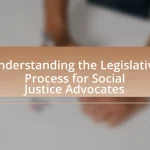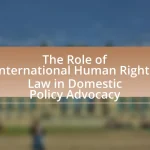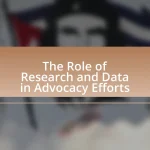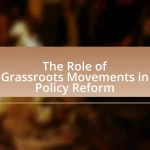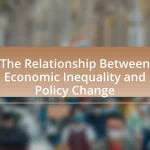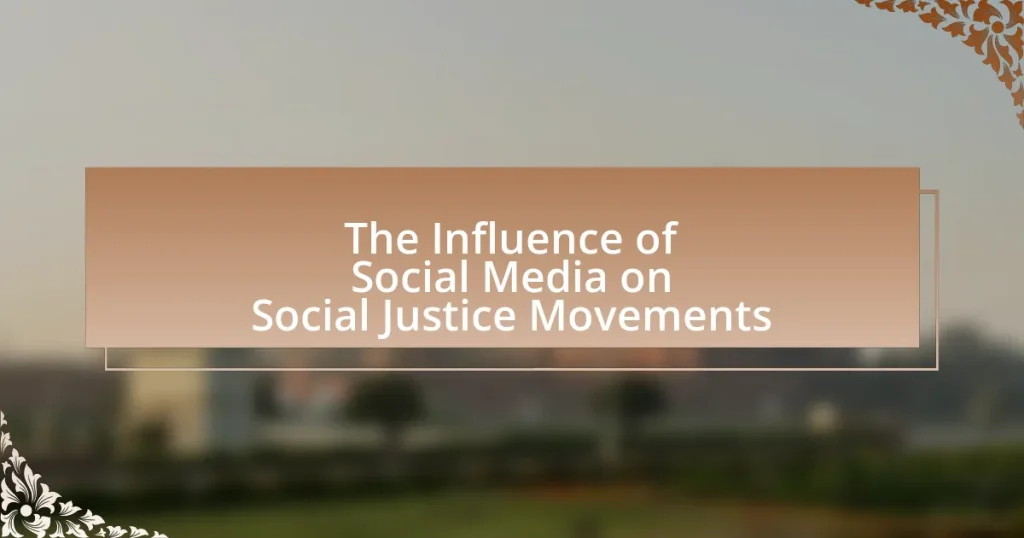The article examines the significant influence of social media on social justice movements, highlighting how platforms like Twitter and Facebook facilitate rapid communication, mobilization, and awareness. It discusses the transformative role of social media in activism, enabling grassroots organizing and amplifying marginalized voices, as evidenced by movements such as Black Lives Matter and #MeToo. The article also addresses the challenges faced by these movements, including misinformation, online harassment, and algorithmic bias, while exploring strategies for effective engagement and the future trends of social media in activism. Overall, it underscores the critical role social media plays in shaping public discourse and driving social change.

What is the Influence of Social Media on Social Justice Movements?
Social media significantly influences social justice movements by facilitating rapid communication, mobilization, and awareness. Platforms like Twitter and Facebook allow activists to share information, organize protests, and amplify marginalized voices, leading to increased visibility for social justice issues. For instance, the Black Lives Matter movement gained global traction through social media, with the hashtag #BlackLivesMatter being used millions of times to raise awareness about police brutality and systemic racism. Research by the Pew Research Center indicates that 69% of adults in the U.S. believe social media is an effective tool for raising awareness about social issues, demonstrating its critical role in shaping public discourse and driving social change.
How has social media changed the landscape of social justice activism?
Social media has transformed social justice activism by providing a platform for rapid information dissemination and mobilization. Activists can now reach a global audience instantly, allowing movements like Black Lives Matter and #MeToo to gain traction and visibility in unprecedented ways. According to a 2020 study published in the Journal of Communication, 70% of social media users reported that they engaged in social justice activities online, demonstrating the significant role these platforms play in fostering community and activism. Additionally, social media enables grassroots organizing, allowing individuals to coordinate protests and campaigns without traditional media gatekeeping, thus democratizing the process of activism.
What role do platforms like Twitter and Facebook play in mobilizing movements?
Platforms like Twitter and Facebook serve as critical tools for mobilizing movements by facilitating rapid communication and information dissemination among users. These platforms enable activists to organize events, share resources, and raise awareness on social justice issues, significantly amplifying their reach. For instance, the Black Lives Matter movement utilized Twitter to coordinate protests and share real-time updates, leading to widespread participation and global attention. Research by the Pew Research Center indicates that 69% of adults in the U.S. use Facebook, making it a powerful medium for grassroots organizing and community building. Additionally, Twitter’s trending topics feature allows movements to gain visibility, attracting new supporters and fostering solidarity across diverse groups.
How do hashtags contribute to awareness and engagement in social justice issues?
Hashtags significantly enhance awareness and engagement in social justice issues by creating a unified platform for discourse and mobilization. They serve as digital rallying points, allowing users to easily find and participate in conversations surrounding specific causes, such as #BlackLivesMatter or #MeToo. Research indicates that the use of hashtags can increase visibility; for instance, a study published in the Journal of Communication found that tweets containing hashtags related to social justice issues received 100% more engagement than those without. This increased engagement fosters community building and encourages collective action, amplifying the reach and impact of social justice movements.
Why is social media a powerful tool for social justice movements?
Social media is a powerful tool for social justice movements because it enables rapid information dissemination and mobilization of supporters. Platforms like Twitter and Facebook allow activists to share real-time updates, organize events, and amplify marginalized voices, reaching a global audience instantly. For instance, the #BlackLivesMatter movement gained significant traction through social media, leading to widespread protests and policy discussions following incidents of police violence. Research by the Pew Research Center indicates that 69% of adults in the U.S. use social media, making it an effective channel for raising awareness and fostering community engagement around social justice issues.
What are the advantages of using social media for activism compared to traditional methods?
Social media offers several advantages for activism compared to traditional methods, primarily through its ability to reach a wider audience quickly and facilitate real-time engagement. Unlike traditional activism, which often relies on physical gatherings and printed materials, social media platforms enable activists to disseminate information instantly to millions of users globally. For instance, the #BlackLivesMatter movement gained significant traction through Twitter and Instagram, mobilizing support and raising awareness rapidly following incidents of police violence. Additionally, social media allows for the organization of events and campaigns with minimal resources, as seen in the viral spread of the Ice Bucket Challenge, which raised over $115 million for ALS research in just a few months. This immediacy and accessibility empower marginalized voices, enabling grassroots movements to gain visibility and support that might be unattainable through conventional channels.
How does social media facilitate global connections among activists?
Social media facilitates global connections among activists by providing a platform for real-time communication and collaboration across geographical boundaries. This connectivity allows activists to share resources, strategies, and experiences, fostering a sense of solidarity and collective action. For instance, during the Arab Spring, platforms like Twitter and Facebook enabled activists in different countries to coordinate protests and share information rapidly, demonstrating the power of social media in mobilizing global movements. Additionally, studies have shown that social media can amplify marginalized voices, allowing activists to reach wider audiences and gain international support for their causes.
What challenges do social justice movements face on social media?
Social justice movements face significant challenges on social media, including misinformation, algorithmic bias, and online harassment. Misinformation can undermine the credibility of movements, as false narratives spread rapidly, confusing the public and detracting from legitimate issues. Algorithmic bias can limit the visibility of social justice content, as platforms prioritize certain types of engagement over others, often sidelining marginalized voices. Additionally, online harassment poses a serious threat to activists, leading to intimidation and discouragement, which can stifle participation and diminish the effectiveness of campaigns. These challenges collectively hinder the ability of social justice movements to mobilize support and achieve their goals effectively.
How do misinformation and disinformation impact social justice campaigns?
Misinformation and disinformation significantly undermine social justice campaigns by distorting public perception and eroding trust in legitimate movements. For instance, false narratives can lead to public backlash against social justice initiatives, as seen during the Black Lives Matter protests, where misleading information about the movement’s goals fueled opposition and violence. Additionally, studies indicate that misinformation spreads faster on social media platforms, complicating efforts to mobilize support and create informed dialogue around social justice issues. This dynamic not only hampers the effectiveness of campaigns but also perpetuates systemic inequalities by misrepresenting the realities faced by marginalized communities.
What are the risks of online harassment and censorship for activists?
Online harassment and censorship pose significant risks for activists, undermining their safety and effectiveness. Activists often face targeted attacks, including threats, doxxing, and coordinated harassment campaigns, which can lead to psychological distress and deter them from advocating for their causes. Censorship, whether through platform policies or governmental actions, restricts their ability to communicate and mobilize support, limiting the reach and impact of their messages. For instance, a 2020 report by the Pew Research Center found that 41% of Americans have experienced online harassment, with marginalized groups disproportionately affected, highlighting the pervasive nature of this issue. Additionally, studies indicate that social media platforms may censor content related to social justice movements, further silencing activists and hindering their efforts to effect change.

How do social media campaigns influence public perception of social justice issues?
Social media campaigns significantly influence public perception of social justice issues by amplifying awareness and facilitating engagement. These platforms enable rapid dissemination of information, allowing movements like Black Lives Matter to reach global audiences quickly, as evidenced by the hashtag #BlackLivesMatter trending worldwide during protests. Research indicates that social media can shape attitudes and mobilize support; for instance, a study published in the Journal of Communication found that exposure to social media content related to social justice increases individuals’ likelihood of participating in activism. This demonstrates that social media not only informs but also actively shapes public discourse around social justice issues.
What strategies do movements use to shape narratives on social media?
Movements shape narratives on social media through strategies such as hashtag campaigns, storytelling, and influencer partnerships. Hashtag campaigns, like #BlackLivesMatter, create a unified message that can spread rapidly, increasing visibility and engagement. Storytelling allows movements to humanize issues, making them relatable and emotionally impactful, as seen in the personal accounts shared during the #MeToo movement. Influencer partnerships leverage the reach of popular figures to amplify messages, as demonstrated by various social justice movements collaborating with celebrities to draw attention to their causes. These strategies effectively mobilize support and foster community engagement, demonstrating the power of social media in shaping public discourse around social justice issues.
How do visual content and storytelling enhance engagement on social media?
Visual content and storytelling significantly enhance engagement on social media by capturing attention and evoking emotional responses. Research indicates that posts with images receive 94% more views than those without, demonstrating the power of visuals in attracting users. Additionally, storytelling creates a narrative that resonates with audiences, making them more likely to share and interact with the content. A study by the Nielsen Norman Group found that people remember stories up to 22 times more than facts alone, highlighting the effectiveness of storytelling in fostering deeper connections. Together, these elements drive higher engagement rates, making social media a vital tool for social justice movements to amplify their messages.
What role do influencers play in amplifying social justice messages?
Influencers play a crucial role in amplifying social justice messages by leveraging their large followings to raise awareness and mobilize support for various causes. Their ability to reach diverse audiences allows them to disseminate information quickly and effectively, often leading to increased visibility for social justice issues. For instance, during the Black Lives Matter movement, influencers like Kim Kardashian and LeBron James used their platforms to advocate for racial equality, resulting in significant public engagement and donations to related organizations. This demonstrates that influencers can significantly impact public discourse and action surrounding social justice initiatives.
How do social media platforms affect the sustainability of social justice movements?
Social media platforms significantly enhance the sustainability of social justice movements by facilitating rapid information dissemination and fostering community engagement. These platforms allow activists to share updates, mobilize supporters, and raise awareness on a global scale, which is crucial for maintaining momentum in social justice causes. For instance, the Black Lives Matter movement gained international traction through social media, leading to widespread protests and policy discussions following incidents of racial injustice. Research by the Pew Research Center indicates that 69% of adults in the U.S. use social media, providing a vast audience for social justice messages. This connectivity not only sustains existing movements but also inspires new ones, demonstrating the critical role social media plays in the ongoing fight for social justice.
What are the implications of algorithm changes on movement visibility?
Algorithm changes significantly impact movement visibility by altering how content is prioritized and disseminated on social media platforms. For instance, when algorithms favor certain types of posts or engagement metrics, movements may experience increased or decreased visibility based on these criteria. A study by the Pew Research Center found that algorithmic adjustments can lead to a 50% variance in engagement rates for social justice content, affecting the reach and influence of movements. Consequently, these changes can either amplify marginalized voices or suppress them, directly influencing public awareness and support for social justice initiatives.
How do social media metrics influence campaign strategies?
Social media metrics significantly influence campaign strategies by providing data-driven insights that guide decision-making. These metrics, such as engagement rates, reach, and conversion statistics, allow campaign managers to assess the effectiveness of their content and adjust strategies in real-time. For instance, a study by the Pew Research Center found that 69% of adults in the U.S. use social media, indicating a vast audience that can be targeted based on specific metrics. By analyzing which posts generate the most engagement, campaigns can tailor their messaging to resonate with their audience, thereby increasing the likelihood of achieving their goals.

What are the future trends of social media in social justice movements?
Future trends of social media in social justice movements include increased use of decentralized platforms, enhanced data privacy measures, and the integration of artificial intelligence for targeted advocacy. Decentralized platforms, such as Mastodon, allow for greater user control and reduced censorship, fostering more authentic grassroots movements. Enhanced data privacy measures are becoming essential as activists seek to protect their identities and communications from surveillance, leading to the adoption of encrypted messaging apps like Signal. Furthermore, artificial intelligence is being utilized to analyze social media data, enabling organizations to identify trends, mobilize supporters, and tailor messages effectively, as seen in campaigns like #MeToo and Black Lives Matter, which have successfully leveraged social media analytics to amplify their reach and impact.
How might emerging technologies impact social justice activism?
Emerging technologies significantly enhance social justice activism by facilitating communication, mobilization, and awareness. For instance, social media platforms like Twitter and Facebook allow activists to disseminate information rapidly, organize protests, and engage a global audience. According to a study by the Pew Research Center, 69% of adults in the U.S. use social media, which amplifies the reach of social justice messages and fosters community support. Additionally, technologies such as live streaming and mobile apps enable real-time documentation of events, increasing accountability and transparency. This technological integration has been pivotal in movements like Black Lives Matter, where hashtags and viral content have driven widespread attention and action against systemic injustices.
What role will artificial intelligence play in shaping social media campaigns?
Artificial intelligence will play a crucial role in shaping social media campaigns by enhancing targeting, content creation, and engagement analysis. AI algorithms can analyze vast amounts of data to identify audience preferences and behaviors, allowing marketers to tailor campaigns more effectively. For instance, a study by McKinsey & Company found that companies using AI for marketing saw a 10-20% increase in engagement rates. Additionally, AI tools can automate content generation and optimize posting times, further increasing campaign efficiency. This data-driven approach enables social justice movements to amplify their messages and mobilize support more effectively on social media platforms.
How can virtual reality and augmented reality enhance activism experiences?
Virtual reality (VR) and augmented reality (AR) can enhance activism experiences by immersing individuals in compelling narratives that evoke empathy and understanding. These technologies allow activists to create realistic simulations of social issues, enabling users to experience the challenges faced by marginalized communities firsthand. For instance, a VR experience that simulates the conditions of refugees can foster a deeper emotional connection and motivate action among viewers. Research indicates that immersive experiences can increase empathy levels significantly; a study published in the journal “Computers in Human Behavior” found that participants who engaged with VR content related to social issues reported higher empathy scores compared to those who consumed traditional media. Thus, VR and AR serve as powerful tools for activism by transforming abstract social justice issues into tangible experiences that inspire engagement and advocacy.
What best practices can activists adopt for effective social media engagement?
Activists can adopt several best practices for effective social media engagement, including creating authentic content, utilizing storytelling, and engaging with followers. Authentic content fosters trust and credibility, as studies show that 86% of consumers value authenticity in brand messaging. Storytelling helps convey complex issues in relatable ways, making it easier for audiences to connect emotionally. Engaging with followers through comments, shares, and direct messages encourages community building and increases visibility, as posts with higher engagement rates are prioritized by social media algorithms. These practices collectively enhance the impact of social justice movements online.
How can movements create inclusive and diverse online spaces?
Movements can create inclusive and diverse online spaces by actively promoting representation and amplifying marginalized voices. By utilizing social media platforms, movements can engage diverse communities, ensuring that various perspectives are heard and valued. For instance, the #BlackLivesMatter movement has effectively used Twitter and Instagram to highlight issues faced by Black individuals, fostering a sense of community and solidarity among diverse groups. Research indicates that inclusive online spaces lead to increased participation and engagement, as seen in studies showing that diverse representation in digital activism enhances the effectiveness of campaigns and broadens their reach.
What strategies can be employed to counteract negativity and promote positive dialogue?
To counteract negativity and promote positive dialogue, individuals and organizations can employ strategies such as active listening, reframing negative comments, and fostering inclusive environments. Active listening involves fully engaging with the speaker, which can help to validate their feelings and reduce defensiveness. Reframing negative comments into constructive feedback encourages a shift in perspective, allowing for more productive discussions. Additionally, fostering inclusive environments where diverse voices are heard can enhance understanding and collaboration, as evidenced by research from the Harvard Business Review, which highlights that diverse teams are more innovative and effective in problem-solving. These strategies collectively contribute to a more positive and constructive dialogue, essential for social justice movements.
